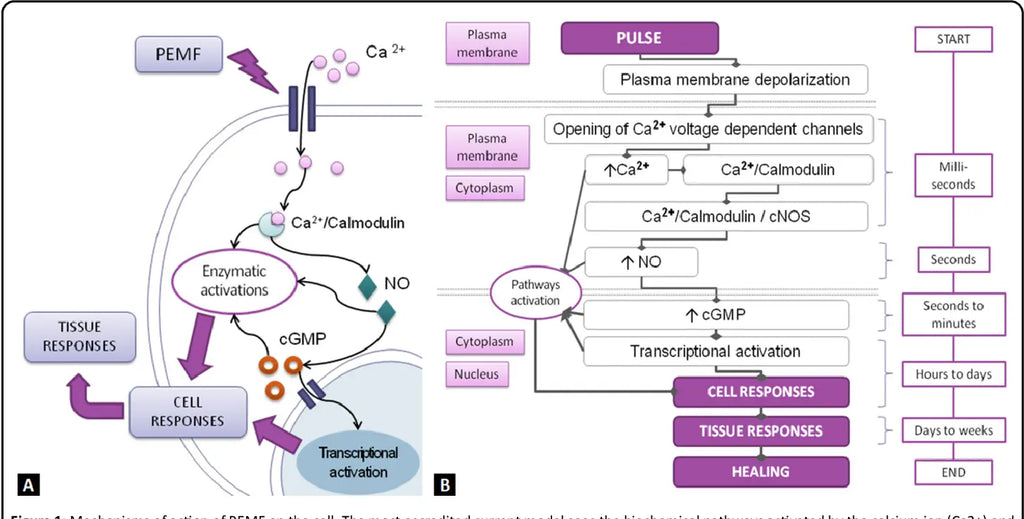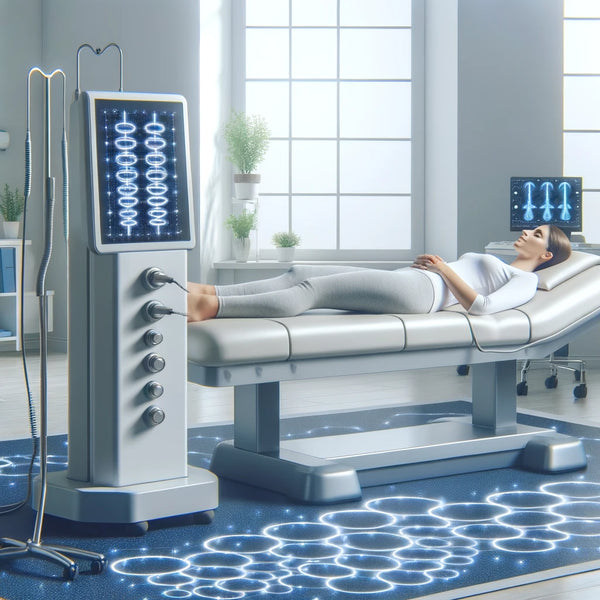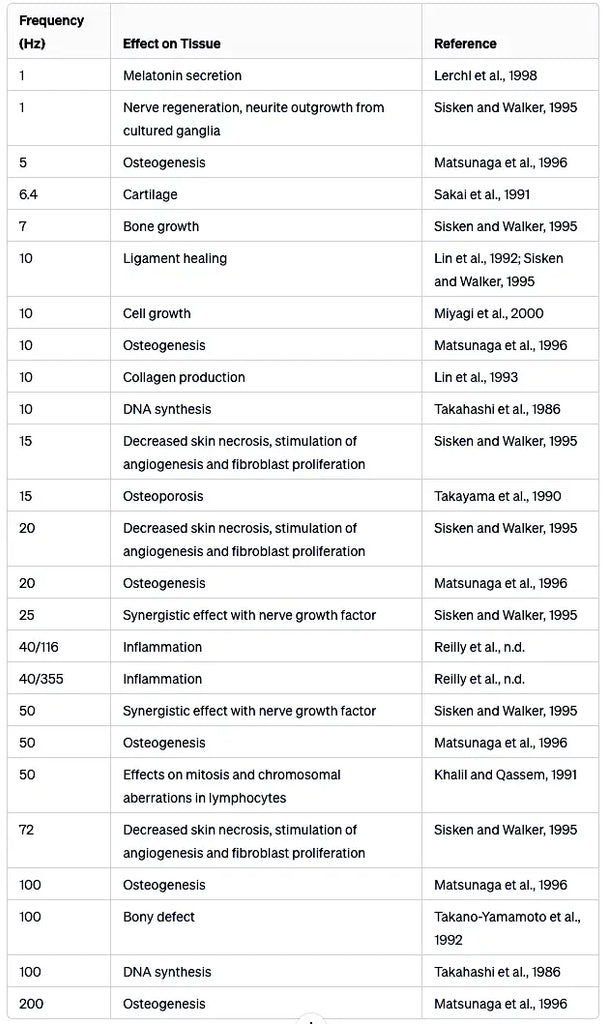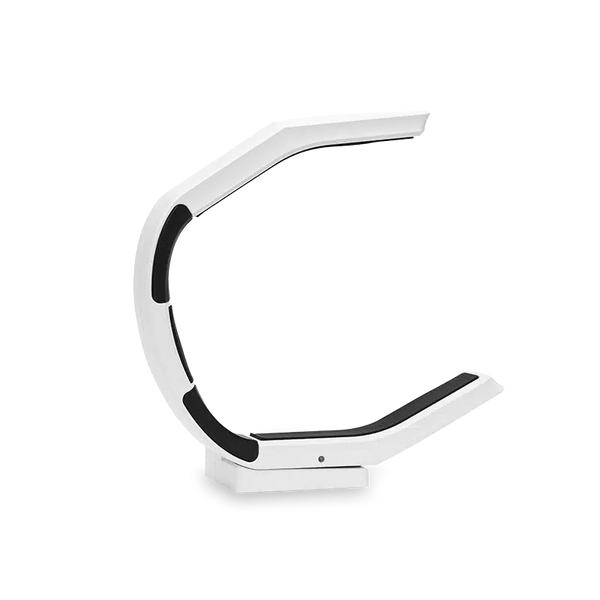PEMF (Pulsed Electromagnetic Field) therapy is gaining attention in the healthcare community for its non-invasive approach to treating various health issues. This article offers a detailed look at PEMF therapy, explaining how it works, its benefits and its applications in modern medicine. Ideal for healthcare professionals and individuals seeking alternative treatments, this guide provides clear insights into PEMF therapy, supported by scientific research and patient experiences. Discover how this innovative treatment can contribute to better health and wellness.
Pulsating electromagnetic radiation is intended to have specific physiological effects on the desired body area. As early as the 1950s, it was discovered that electrical potential affects bone growth. In 1974, positive studies were published on the effects of pulsed magnetic therapy on the healing of fractures and various tissues.(1-2) Since then, several hundred studies on PEMF therapy have been published in animals and humans.
Mechanisms of action
Pulsed Electromagnetic Field (PEMF) therapy is complicated and involves many natural cell processes. PEMF therapy works by causing electrical changes in cells and their surroundings. This is done by sending out electromagnetic fields. These fields change in how often they happen, their strength and how long they last. It all depends on what kind of use or goal the therapy has for them.(3)
The most accredited current model sees the biochemical pathways activated by the calcium ion (Ca2+) and subsequently by the nitric oxygen (NO) and cGMP as the key mechanisms of the action of PEMFs at the cellular level and, consequently, on the responses of tissues.(4)

Image: Mechanisms of action of PEMF on the cell.
Source: Luigi, C. & Tiziano, P. (2020). Mechanisms of Action And Effects of Pulsed Electromagnetic Fields (PEMF) in Medicine. Journal of Medical Research and Surgery 1 (6): 1-4.
Induction of Electrical Changes
Every cell in the body has an electrical charge, crucial for maintaining its normal function. PEMF therapy influences these charges by inducing electrical changes in the cells. This electromagnetic induction stimulates cells and recharges their membranes, thus enhancing their overall functionality.
Stimulation of Cellular Metabolism
Pulsed electromagnetic fields (PEMFs) show potential effects on certain human cell types, with higher frequencies, flux densities and chronic exposure more effective in establishing a cellular response leading to a cellular "recharge." This enhanced energy production is crucial for maintaining efficient cellular metabolism. Increased cellular energy translates into higher functionality, from cellular repair and regeneration to more efficient cellular signaling.(5)
Enhancement of Blood Circulation
The electromagnetic fields generated by PEMF therapy significantly affect blood vessels. They stimulate the dilation of blood vessels, thereby increasing blood flow. Enhanced circulation ensures that more oxygen and nutrients are delivered to the tissues but also aids in removing waste products. This process is vital for healing and the maintenance of healthy tissues. PEMF therapy may also improve blood pressure due to its vascular effects.(6)
Promotion of Tissue Regeneration
PEMF treatment helps speed up the healing and growth of different body parts, including bone, muscle and nerve cells. PEMF triggers different cellular paths that support the growth and specialization of cells.(7) The electromagnetic fields enhance the production of proteins and other essential components needed for tissue repair, making it a valuable tool in recovery from injuries and surgeries.
Modulation of Cellular Communication
The therapy also influences the way cells communicate with each other. Cells communicate through electrical and chemical signals; PEMF therapy can enhance these signaling pathways. Improved cellular communication leads to more coordinated tissue and organ function, essential for maintaining homeostasis and overall health.
Influence on Ion Channels and Cellular Membranes
PEMF treatment changes how easily substances can pass through cell walls. Managing the ion paths on a cell's surface allows calcium, sodium and potassium ions to enter and exit the cell.(8) This ion exchange is very important for different functions in cells. These include muscle contraction, nerve signaling and control of cell growth cycles.

Over the past two decades, whole-body PEMF systems that can improve, for example, microcirculation and metabolism have been developed.(9) Devices have also been found to accelerate the repair of various tissues and help relieve pain. According to a meta-analysis published in 2009, PEMFT can relieve pain and improve functioning in people with osteoarthritis of the knee.(10) Some people also use devices as forms of stress-relieving therapy.
PEMF therapy can accelerate recovery from exercise and, among other things, increase vagus nerve function and increase heart rate variability (HRV).(11) According to a 4-year study published by NASA, PEMF therapy is beneficial in regenerating nervous system stem cells.(12) Prefrontal Transcranial Magnetic Stimulation (TMS) can help treat depression.(13)
Brain-Specific Benefits of PEMF Therapy
One of the critical areas where PEMF therapy shows potential in brain and nervous system health is in neurological recovery, particularly following traumatic brain injuries and strokes. The therapy helps repair damaged neural tissues, thereby enhancing functional recovery. This aspect is crucial for patients dealing with the long-term effects of neurological injuries.(14-15)

PEMF therapy has also been researched for its role in pain management, especially for conditions like chronic migraines and tension headaches. By altering pain signals in the brain and addressing underlying inflammation, PEMF can offer a non-invasive option for pain relief.(16-17) Furthermore, there are indications that PEMF therapy can positively impact cognitive functions, including memory and concentration, by improving neural efficiency and brain wave modulation.(18) The positive cognitive effects are particularly relevant for aging populations and those at risk of cognitive decline.
Brainwave frequencies and functions:
- Delta waves – (0.1 – 4 Hz) (sleep)
- Theta waves – (4 – 7 Hz) (learning and meditative state)
- Alpha waves – (8 – 15 Hz) (familiar activities and relaxation; these decrease if something out of the ordinary is observed)
- "Mu" waves – (7.5 – 12.5 Hz) (rhythm that supports other functions)
- SMR waves – (12.5 – 15.5 Hz) (rhythm that supports other functions)
- Beta waves – (16 – 31 Hz) (cognitive performance and mental activity).
- Gamma waves – (32 – 140 Hz) (working, active working)
PEMF therapy may also help in mood regulation and mental health. Studies suggest its potential to improve conditions such as depression and anxiety, possibly by influencing neurotransmitter levels and neural pathways.(19-20) PEMF therapy can enhance sleep quality by promoting relaxation and positively affecting brain wave patterns, benefiting those with insomnia or sleep disturbances.(21)
Interestingly, PEMF therapy's potential to boost neuroplasticity — the brain's ability to form new neural connections — is promising for learning enhancement and recovery from brain injuries.(22-24) Additionally, its effects on reducing brain inflammation and stress make it a fascinating option for a holistic approach to brain health.(25)
For brain PEMF therapy, we recommend the cutting-edge and scientifically validated Neorhythm OmniPEMF device. NeoRhythm offers the only non-invasive technology that lets you choose your state of mind. Designed to help you calm down, sleep better, relax, de-stress, increase focus and more.
PEMF Therapy's Impact on Different Organ Systems
- Musculoskeletal System: PEMF therapy is effective in healing bone and muscle issues like osteoarthritis and fractures. It strengthens bones and helps them heal quicker, along with soft body parts.(26)
- Nervous System: Studies show that PEMFT has positive effects on neuroplasticity, aiding recovery from traumatic brain injuries and strokes. Additionally, it helps in managing chronic pain and neuropathic conditions.
- Cardiovascular System: It helps improve blood flow, decrease swelling, and improve a part of the body that lines our blood vessels. This could be useful for dealing with health problems such as high blood pressure and issues in the small arteries far from our heart.
- Immune System: PEMF treatment can modify the body's immune reaction, which might help with diseases caused by immune system problems and strengthen overall immune defense.(27)
- Gastrointestinal System: Early research shows that PEMF could help reduce signs and symptoms of irritable bowel syndrome (IBS).(28)
PEMF therapy uses low-frequency (0–40 Hz) and low-intensity (10–200 milligauss) radiation, which is very close to the ground vibration level of 3–60 Hz (so-called Schumann resonance).(29-30) Various frequencies can stimulate different tissues to achieve the desired health effects (see table below).(31) The most commonly used frequency is 10 Hz. Similarly, many potentially harmful technological devices use significantly higher frequencies, such as smartphones (450-2700 MHz) and wireless base stations (2.4-5.9 GHz).(32-33)

Image: Effects of different frequencies at the tissue level.
Source: Oschman, J. (2016). Energy Medicine: The Scientific Basis (2nd edition). London: Elsevier" for the original context and scientific accuracy.
Conclusion
PEMF (Pulsed Electromagnetic Field) therapy significantly advances medical and self-administered treatments, offering broad therapeutic benefits across various organ systems. Its non-invasive nature and effectiveness in improving cellular function and promoting healing make it a practical and effective tool in preventive and integrated healthcare. While it shows promise in pain management, bone healing, and nervous system recovery, its full potential is still being explored. Ongoing research is essential to understand its capabilities further and expand its medical applications. As studies continue, PEMF therapy holds the potential to revolutionize aspects of patient care and wellness, demonstrating a unique blend of safety and efficacy in treatment similar to other non-invasive treatment methods, such as photobiomodulation and light therapies.
Scientific References:
- Bassett, C. & Pawluk, R. & Pilla, A. (1974). Acceleration of fracture repair by electromagnetic fields. A surgically noninvasive method. Annals of the New York Academy of Sciences 238: 242–262.
- Bassett, C. & Pawluk, R. & Pilla, A. (1974). Augmentation of bone repair by inductively coupled electromagnetic fields. Science 184 (4136): 575–577.
- Flatscher, J., Pavez Loriè, E., Mittermayr, R., Meznik, P., Slezak, P., Redl, H., & Slezak, C. (2023). Pulsed Electromagnetic Fields (PEMF)—Physiological Response and Its Potential in Trauma Treatment. International Journal of Molecular Sciences, 24(14), 11239.
- Luigi, C. & Tiziano, P. (2020). Mechanisms of Action And Effects of Pulsed Electromagnetic Fields (PEMF) in Medicine. Journal of Medical Research and Surgery 1 (6): 1-4.
- Mansourian, M., & Shanei, A. (2021). Evaluation of pulsed electromagnetic field effects: A systematic review and meta-analysis on highlights of two decades of research in vitro studies. BioMed Research International 6647497.
- Stewart, G. M., Wheatley‐Guy, C. M., Johnson, B. D., Shen, W. K., & Kim, C. H. (2020). Impact of pulsed electromagnetic field therapy on vascular function and blood pressure in hypertensive individuals. The Journal of Clinical Hypertension, 22(6), 1083-1089.
- Schnoke, M., & Midura, R. J. (2007). Pulsed electromagnetic fields rapidly modulate intracellular signaling events in osteoblastic cells: comparison to parathyroid hormone and insulin. Journal of orthopaedic research, 25(7), 933-940.
- Petecchia, L. et al. (2015). Electro-magnetic field promotes osteogenic differentiation of BM-hMSCs through a selective action on Ca2+-related mechanisms. Scientific reports, 5(1), 13856.
- Klopp, R. & Niemer, W. & Schmidt, W. (2013). Effects of various physical treatment methods on arteriolar vasomotion and microhemodynamic functional characteristics in case of deficient regulation of organ blood flow. Results of a placebo-controlled, double-blind study. Journal of Complementary and Integrative Medicine 10 (Suppl): S39–46.
- Vavken, P. & Arrich, F. & Schuhfried, O. & Dorotka, R. (2009). Effectiveness of pulsed electromagnetic field therapy in the management of osteoarthritis of the knee: a meta-analysis of randomized controlled trials. Journal of Rehabilitation Medicine 41 (6): 406–411.
- Grote, V. et al. (2007). Short-term effects of pulsed electromagnetic fields after physical exercise are dependent on autonomic tone before exposure. European Journal of Applied Physiology 101 (4): 495–502.
- Goodwin, T. (2003). Physiological and molecular genetic effects of time-varying electromagnetic fields on human neuronal cells. NASA/TP-2003-212054.
- Perera, T. et al. (2016). The Clinical TMS Society Consensus Review and Treatment Recommendations for TMS Therapy for Major Depressive Disorder. Brain Stimulation 9 (3): 336–346. Review.
- Capone, F. et al. (2022). Pulsed electromagnetic fields: a novel attractive therapeutic opportunity for neuroprotection after acute cerebral ischemia. Neuromodulation: Technology at the Neural Interface, 25(8), 1240-1247.
- Bragin, D. E., Statom, G. L., Hagberg, S., & Nemoto, E. M. (2015). Increases in microvascular perfusion and tissue oxygenation via pulsed electromagnetic fields in the healthy rat brain. Journal of neurosurgery, 122(5), 1239-1247.
- Feng, Y., Zhang, B., Zhang, J., & Yin, Y. (2019). Effects of non‐invasive brain stimulation on headache intensity and frequency of headache attacks in patients with migraine: a systematic review and meta‐analysis. Headache: The Journal of Head and Face Pain, 59(9), 1436-1447.
- Thomas, A. W., Graham, K., Prato, F. S., McKay, J., Forster, P. M., Moulin, D. E., & Chari, S. (2007). A randomized, double-blind, placebo-controlled clinical trial using a low-frequency magnetic field in the treatment of musculoskeletal chronic pain. Pain Research and Management, 12, 249-258.
- Drumond Marra, H. L., Myczkowski, M. L., Maia Memória, C., Arnaut, D., Leite Ribeiro, P., Sardinha Mansur, C. G., ... & Marcolin, M. A. (2015). Transcranial magnetic stimulation to address mild cognitive impairment in the elderly: a randomized controlled study. Behavioural neurology, 2015.
- Karabanov, A. N., & Siebner, H. R. (2014). Expanding the electrotherapeutic toolkit: a perspective on transcranial pulsating electromagnetic fields (T-PEMF). Acta Neuropsychiatrica, 26(5), 261-263.
- Peng, Z., Zhou, C., Xue, S., Bai, J., Yu, S., & Li, X. Mechanism of repetitive transcranial magnetic stimulation for depression. Shanghai Arch Psychiatry. 2018; 30 (2): 84–92.
- Nardone, R., Sebastianelli, L., Versace, V., Brigo, F., Golaszewski, S., Pucks-Faes, E., ... & Trinka, E. (2020). Effects of repetitive transcranial magnetic stimulation in subjects with sleep disorders. Sleep medicine, 71, 113-121.
- Hallett, M. (2007). Transcranial magnetic stimulation: a primer. Neuron 55 (2): 187–199.
- Jannati, A. & Oberman, L. & Rotenberg, A. & Pascual-Leone, A. (2023). Assessing the mechanisms of brain plasticity by transcranial magnetic stimulation. Neuropsychopharmacology 48 (1): 191–208.
- Auriat, A. & Neva, J. & Peters, S. & Ferris, J. & Boyd, L. (2015). A review of transcranial magnetic stimulation and multimodal neuroimaging to characterize post-stroke neuroplasticity. Frontiers in Neurology 6: 226.
- Vincenzi, F., Ravani, A., Pasquini, S., Merighi, S., Gessi, S., Setti, S., ... & Varani, K. (2017). Pulsed electromagnetic field exposure reduces hypoxia and inflammation damage in neuron‐like and microglial cells. Journal of Cellular Physiology, 232(5), 1200-1208.
- Tong, J., Chen, Z., Sun, G., Zhou, J., Zeng, Y., Zhong, P., ... & Liao, Y. (2022). The efficacy of pulsed electromagnetic fields on pain, stiffness, and physical function in osteoarthritis: A systematic review and meta-analysis. Pain Research and Management, 2022.
- Ross, C. L., Zhou, Y., McCall, C. E., Soker, S., & Criswell, T. L. (2019). The use of pulsed electromagnetic field to modulate inflammation and improve tissue regeneration: A review. Bioelectricity, 1(4), 247-259.
- Gretsch, A. J. (2021). Use of Low-Intensity, Pulsed Electromagnetic Fields (PEMF) to Reduce Signs and Symptoms of Irritable Bowel Syndrome (IBS): A Small Randomized, Single-Blind Sham Controlled Study (Doctoral dissertation, Saybrook University).
- Muehsam, D. & Ventura, C. (2014). Life Rhythm as a Symphony of Oscillatory Patterns: Electromagnetic Energy and Sound Vibration Modulates Gene Expression for Biological Signaling and Healing. Global Advances in Health and Medicine 3 (2): 40–55.
- Mitsutake, G. et al. (2005). Does Schumann resonance affect our blood pressure?Biomedicine & Pharmacotherapy = Biomedecine and Pharmacotherapie 59 (Suppl 1): S10–S14.
- Oschman, J. (2016). Energy Medicine: The Scientific Basis (2nd edition). London: Elsevier.
- Prasad, M. & Kathuria, P. & Nair, P. & Kumar, A. & Prasad, K. (2017). Mobile phone use and risk of brain tumours: a systematic review of association between study quality, source of funding, and research outcomes. Neurological Sciences 38 (5): 797–810.
- Markov, M. & Grigoriev, Y. (2013). Wi-Fi technology--an uncontrolled global experiment on the health of mankind. Electromagnetic Biology and Medicine 32 (2): 200–208.






